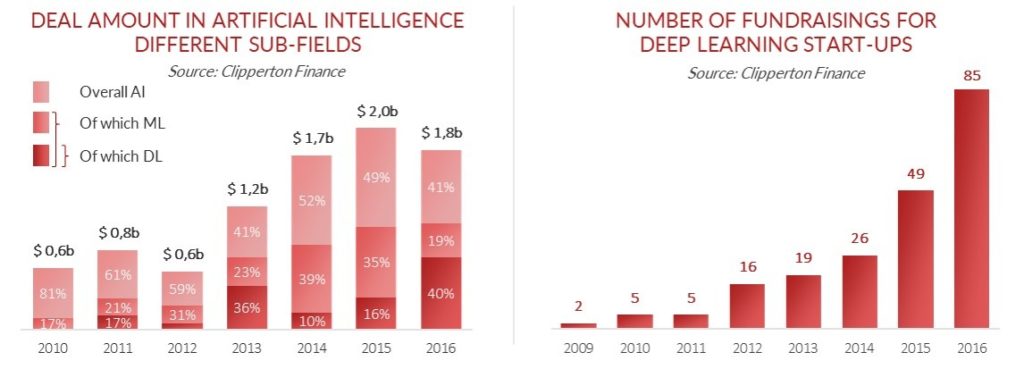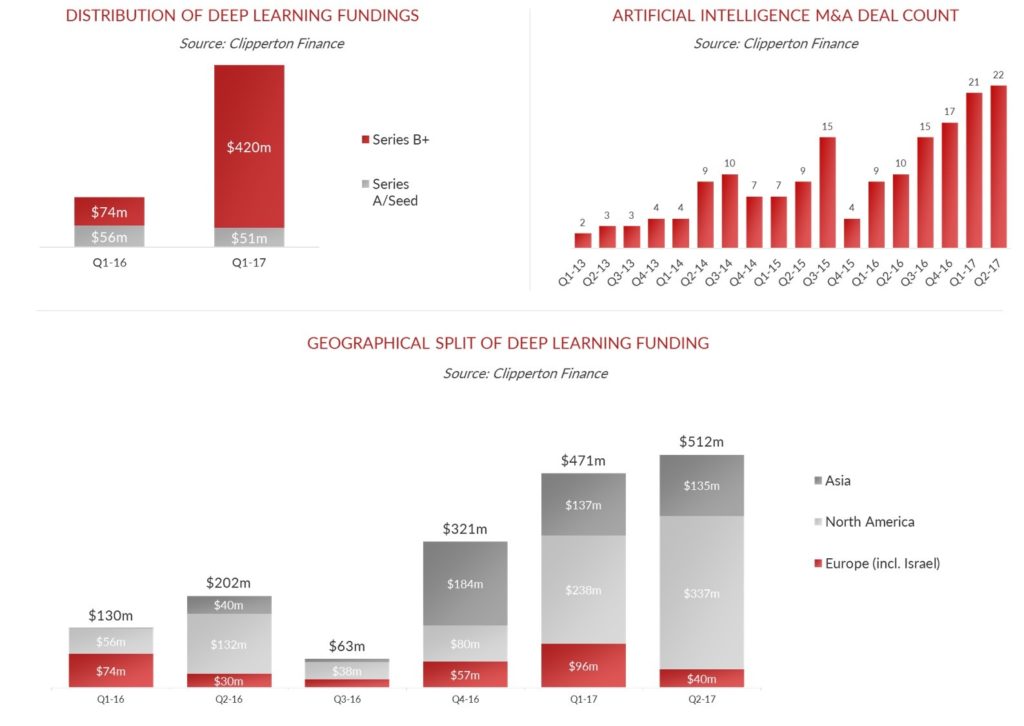You can download the full report here.
DEEP LEARNING IS THE LATEST BUILDING BLOCK OF THE A.I. REVOLUTION WITH THE POTENTIAL TO DEVELOP NUMEROUS DISRUPTIVE APPLICATIONS.
Deep Learning is the latest newcomer in the Artificial Intelligence family. First (re)emerging in the industry around 2012, Deep Learning has really been on all VCs’ lips for the last 18 months, and on the agenda of technology giants (GAFA, Microsoft, IBM, Baidu, etc.). With €717m raised in 2016 i.e. 40% of Artificial Intelligence funding (vs. €316m, i.e. 16% in 2015), 2016 was clearly the year of take-off for Deep Learning start-ups
Yet, Deep Learning is not a new topic and has been discussed since the early 1970’s as a sub-field of Machine Learning and more broadly of Artificial Intelligence, with the idea to imitate through algorithms the way the human brain works with neural networks & complex feedback loops. Then an intellectual vision – or even a fantasy back in the 70s – Deep Learning is now an emerging disruption:
- Deep Learning has proven it is able to deliver tremendous results and tackle new problems that no other field of Artificial Intelligence has ever achieved. It then represents the most realistic opportunity to further progress towards a self-learning artificial intelligence
- It is in everybody’s daily lives: new applications of Deep Learning emerge every week and become already mainstream, with the most noticeable example being the major breakthrough in autonomous cars, but also in Healthcare, E-commerce, Chatbots and even in more traditional industries like agriculture.
WHY NOW?
We believe 3 major factors that were limiting deep learning’s development so far changed drastically and are now favoring its explosion:
- Data availability: To be efficient, Deep Learning needs a lot of data, and more importantly, high quality data. The emergence of mobile and cloud infrastructures have allowed to collect and store such data at marginal cost.
- Computing Power: Increase in computing power is still keeping up with Moore’s law and the amount of readily accessible power opens up new possibilities, including the capacity to manage the huge datasets required by Deep Learning techniques.
- Better algorithms & teams: The previous works on Machine Learning could be applied to Deep Learning: new teams got formed with talented people (Yann Le Cun now at Facebook, Andrew Ng formerly at Google & Baidu etc.) who are now leading the innovation in the field.

MATURATION OF A BREAKTHROUGH TECHNOLOGY
However, times are still early, and some level of caution needs to be taken – Artificial Intelligence has already gone through several “winters” during its long history. It is a complex topic and it can be sometimes hard to sort out who is really leveraging the full extent of the power of the technology, and who is “Deep-Learning-washing”.
In the recent years, and even more particularly in 2016, lots of start-ups using Deep Learning were launched and funded by VC funds (but mostly seed round or Serie A), but a very few minority have reached the commercial phase. There was also some activity on the M&A side, but most companies were acqui-hired (by tech giants mostly) before having tested their product on the market.
2017-18 WILL THEN BE CRUCIAL YEARS FOR DEEP LEARNING AND WILL DETERMINE:
- Is Deep Learning only a fad (remember SoLoMo)?
No – We forecast the impact of Deep Learning on the economy overall will be massive, from Agriculture to Automobile but also the way we will work, take decisions and interact. Fair enough, some “Deep Learning-washing” is expected but make no mistake, this will be huge, for real. - Will it become a commodity – the new Mobile or Cloud?
Yes, but this will take some time – We anticipate the value at stake of mastering Deep Learning will go down significantly over time, and will be part of our digital world as a core component. As such, strategic positions will be taken, be it at the infrastructure level or at the service/vertical integration level. - Which companies will be able to raise growth equity round (industrialization phase) and/or lead to big exits?
Mainly vertical players – We believe that the Internet giants (GAFAMIBA1) will keep on developing their infrastructure/platform play but that numerous vertical initiatives will allow start-ups to create massive returns, including in the healthcare sector, in the agritech segment and many others.

You can download the full report here.
For more information, please contact:
- Stéphane Valorge, Partner, svalorge@clipperton.net
- Olivier Combaudou, Vice-President, ocombaudou@clipperton.net
- Théodore Chastel, Senior Analyst, tchastel@clipperton.net
About Clipperton
Clipperton is a European independent corporate finance advisory firm exclusively dedicated to the Technology space, advising innovative companies on M&A transactions, debt financings and equity offerings. With offices in London, Berlin, and Paris and an international reach, Clipperton is a European leader in Technology financial advisory. Over the past 15 years, the team has successfully completed more than 200 high profile transactions globally.
